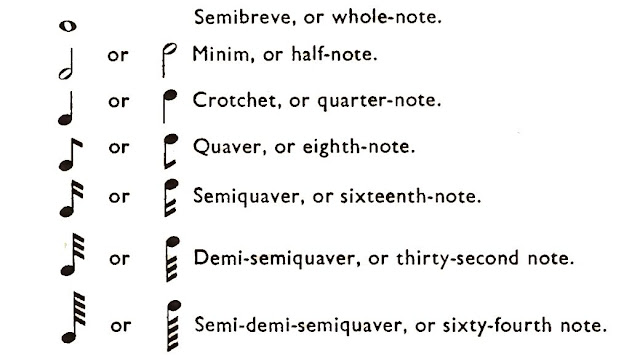Rudiments of Music - a music-theory overview
Chapter 1
The relative duration of musical sounds is shown by signs of varying shape called notes.
Those now commonly used are:
Each of the above notes in order is, in duration, half the value of the preceding.
In older notation music, other kinds of notes were used. Of these, three are worth mentioning:
In Germany and America it is customary to describe each note according to its numerical value (whole-note, half-note, etc.), in England, however, the terms semibreve, minim, etc., are generally used. In France, the notes are called respectively Ronde, Blanche, Noire, Croche, Double Croche, Triple Croche, etc.
Of course the notes represent the relative duration of sounds: The actual duration of any particular note depends on the speed at which the music is played or sung. So, a semibreve or minim in a quick movement might very well occupy less time than a crotchet or quaver in a slow one.
It is immaterial whether the stems of minims, crotchets, quavers, etc. are turned up or down; this is frequently regulated, for appearance sake, by their position on the Staff.
When two or more quavers, semiquavers, etc., occur in succession, it is usual for them to be grouped together on one tail, like this:
The duration of any note may be increased by adding one or more
dots after it; a single dot augmenting its value by one-half, eg
and two dots, by three-quarters, e.g. :
A dot always takes half the value of whatever immediately precedes it: The second dot adds half the value of the first dot, i.e., a quarter of the original note.
Sound often pauses during a musical composition, and there is silence for a definite period. Such silences are indicated by Rests, corresponding in duration to the notes whose names they take, viz:
The rest corresponding to the rarely used Breve is written II
Dots are sometimes placed after rests, and increase their duration in the same manner way as for notes.







